方案详情文
智能文字提取功能测试中
PCCP View Article OnlinePaperPCCP Check for updates Cite this: Phys. Chem. Chem.Phys.,2019, 21, 13679 Isomer and conformer selective atmosphericpressure chemical ionisation of dimethylphthalate Bartosz Michalczuk,iD)a Ladislav Moravsky, Peter Papp, Pavel Mach,Martin Saboand Stefan MatejcikD*a Received 12th April 2019,Accepted 27th May 2019 DOI: 10.1039/c9cp02069a In this work we have studied the ionisation mechanism of Atmospheric Pressure Chemical lonisation(ACPI) for three isomers of dimethyl phthalate (dimethyl phthalate -DMP (ortho -isomer), dimethyl iso-phthalate - DMIP (meta) and dimethyl terephthalate - DMTP (para)) using lon Mobility Spectrometry(IMS) and IMS combined with an orthogonal acceleration Time of Flight Mass Spectrometer (oa-TOFMS). The molecules were chemically ionised using reactant ions H*(H2O)(n=3 and 4). The positivelMS and IMS-oaTOF mass spectra of the isomers showed significant differences in the ion mobilities andin the ion composition. The IMS - oaTOF spectra consisted of clusters of ions M·H+·(H2O)n withdifferent degrees of hydration (n =0, 1,2, 3) for different isomers. In the case of the DMP isomer, wehave observed almost exclusive formation of M·H+ by proton transfer ionisation, while in the case ofDMIP and DMTP, hydrated ions M-H*(H2O)n (n = 1,2, 3) and M-H*-(H2O)n (n =0, 1, 2) respectively weredetected, formed via adduct formation reactions. This behaviour was elucidated by differences inionisation processes. In order to elucidate the ionisation processes we have carried out DFT calculationsof the structures and energies of the neutral and protonated and hydrated isomers (for differentconformers) and their corresponding proton affinities (PA) and hydration energies. Introduction Phthalates, also known as phthalate esters, are a group ofchemicals which are widely used in consumer products likechildren’s toys, building materials, pharmaceuticals, furnish-ing, cosmetics, food packaging and many others. Phthalatesare also used as plasticizers in rigid polymers like polyvinylchloride or other polymers. It is worth noting that theircontent can make up to 50% of the final product weight.The problem is that phthalates are produced in large quantitiesand can be easily released from plastics and contaminate soil orwater.The presence of phthalates in the environment can be athreat to nature and to human health. In fact,esters of phthalicacid are thought to be endocrine disruptors.4,5 Hence, thedevelopment of a suitable analytical method is required forthe detection of phthalates in samples with very low concentra-tions and considering economic aspects. ( “Department ofExperimental Physics, Co m enius Univ e rsity, Mlynska doli n a F2, ) ( 1 84248 Bratislava, Slovakia. E-mail : matejcik@fmph.uniba.sk ) ( "Department of Chemistry, Siedlce U n iversity, 3 M aja 5 4 , 08-110 Siedlce, Poland‘ D epartment of Nuclear Physics and Biophysics, Comenius University, ) ( M lynska dolina F1, 8 4248 Bratislava, Slovakia ) ( t Electronic supplementary i n formation (E S I) av a ilable. S e e DO I : 10.1039/c9cp02069a ) In recent years, the problem related to the omnipresence ofphthalates has been identified. That fact is reflected by dozensof scientific reports published recently.6-8 Different analyticaltechniques have been involved in the investigation of phthalates.For instance, high performance liquid chromatography (HPLC)or gas chromatography-mass spectrometry (GC-MS) wereused to determine phthalates in industrial emissions and foodsamples. ,10 Hyphenated techniques, including HPLC-atmosphericpressure chemical ionization tandem mass spectrometry (HPLC-APCI-MS/MS)11 and Liquid Chromatography-Atmospheric PressureChemical Ionization-Mass Spectrometry (LC-APCI-MS)12 are usuallyapplied to study isomeric species. GC or HPLC have advantagessuch as well-developed databases of compounds or the versatilityof these methods, but like every analytical method, they alsohave disadvantages. The main obstacle is a specific preparationmethod for the samples and the later analysis is also a relativelytime-consuming process. Ion mobility spectrometry has some advantages which makethis technique suitable to detect these types of compounds. IMSis a spectrometric method with fast response, i.e., fractions of asecond after the introduction of the sample to the device. Thehigh sensitivity allows detection at very low concentration(down to ppt for some compounds). In many cases, the samplecan be investigated as delivered, without additional purification Table 11 :Structures and vapor pressures for all investigated phthalates asdetermined in the present IMS experiment isomer Vapour pressure (298 K)1 DMP CH3 0.304 Pa CH、 DMIP CHs 0.099 Pa CH, H,C DMTP 0.01 Pa CH, or pre-concentration. The IMS technique was first applied forthe detection of phthalates by Hagen,14 who demonstratedamong others the detection of the dimethyl phthalate isomersby IMS in positive and negative polarity. The detection ofdimethyl phthalates in negative polarity IMS was reported byPoziomek et al.,15 who used IMS for the detection of differentphthalate esters in water. Barnet et a1.16 applied in negativepolarity field asymmetric IMS (FAIMS) combined with a massspectrometer and an electrospray ionization (ESI) ion sourceto separate the three isomers of phthalic acid. Midey et al.presented results where high-performance ion mobility spec-trometry with direct electrospray ionization (ESI-HPIMS) wasused to detect several additives and contaminants in food,including phthalates. In this work we present a study focused on the detectionof the isomers of DMP (Table 1) in positive polarity IMSin combination with an APCI ion source based on coronadischarge of dehumidified ambient air (Table 2). We observedsignificant differences in IMS spectra of the isomers, largeras expected from the geometry differences of the isomers.For this reason, we have studied the mechanism of theseparation in more detail using the IMS-oaTOF instrument.This study revealed that the APCI of DMP isomers results inthe formation of protonated ions with different degrees ofhydration. Table 2Parameters of IMS used in the experiment Operating parameters IMS drift tube length 12.05 cm Electric field intensity 665.5 V cm IMS operating pressure 700 mbar IMS operating temperature 345 K Drift gas flow 400 sccm Sample gas flow 20 sccm CD current 10 uA Shutter grid pulse width 60 ps Shutter grid frequency 16 Hz ExperimentalIMS-oaTOF instrument The IMS-oaTOF MS instrument used in this work is a home-made IMS instrument with APCI ionisation source based oncorona discharge (CD). The spectrometer has been described indetail in the literature.19-21 The IMS was operated in positivepolarity and at sub-atmospheric pressure (700 mbar). Thisoffers simple sampling of volatile organic compounds by thecapillary inlet. All operating parameters are summarized inTable 2. The sample flow rate was controlled by a micro-splitter valve and adjusted by a flow meter (20 ml min-). Theion mobility scale was calibrated using 2,6-di-tert-butylpyridine(Sigma-Aldrich) as a standard compound with the well-knownreduced mobility of 1.42 cm²v-1 s-1.22 The hybrid IMS-oaTOF instrument can be operated in threeworking modes: i) the IMS mode in which IMS spectra arerecorded; (ii) the TOF mode with opened IMS ion gate andcontinuous transport of ions through the IMS to record TOFmass spectra and (iii) the third mode, where the IMS and TOFgates are operated synchronously leading to two dimensionalIMS-MS spectra. In this mode we are able to assign IMS peaksto ions with a particular m/z. Gases and chemicals As a drift gas in IMS, we used zero air generated by a MaSa Techzero air generator and an additional moisture trap (Agilent)resulting in water concentration of ~20 ppm. In the case ofsample flow, non-purified lab air was constantly sucked in,while the IMS was operated in sub-atmospheric pressure. Thesample flow rate was controlled using a micro-splitter valve(Supelco) accompanied by a capillary and a gas flow meter(Platon). The phthalates were supplied from Sigma-Aldrich withthe following purities: dimethyl isophthalate 99%, dimethylphthalate 99%, and dimethyl terephthalate 99%. The vapours of the phthalates were introduced into thereaction region of the IMS through a sample inlet. The phtha-lates were placed in a glass syringe (about 0.5 g) and we waitedfor at least 30 min to achieve an equilibrium between the gasand the solid or liquid phases. Later, the syringe was connectedvia a capillary with the sample inlet and using a syringe pump(Kent Scientific), the sample was introduced into the reactionregion of the IMS with a pre-set flow rate. Results and discussion We have ionised the phthalates using atmospheric pressurechemical ionisation (APCI) by reactant ions (RI) formed in thecorona discharge in the dehumidified ambient air. The ambientair used as a drift gas in the IMS and a feed gas in the APCI wasprocessed by the system of filters and moisture traps, reducing thewater concentration to ~20 ppm level. The positive coronadischarge in this gas and at the temperature of 345 K resultedin the generation of Reactant Ions (RI) H*·(H2O)n (n=3, 4) and asmall amount of NH4 (H20)n (n= 0, 1), as established by the IMS-oaTOF MS. The H*(H20)3,4 ions were dominant RI, therefore, we are going to concentrate on the processes associated with theseions. The APCI ionisation of phthalates in the IMS-oaTOF MSinstrument includes the following reactions of the RI with theanalyte: where M represents an isomer of dimethyl phthalate, n=3 and4, and m=1, 2 and 3. The proton transfer reaction (1) is a veryefficient two-body reaction with a rate coefficient close to thecollision rate if the proton affinity of the molecule PA(M)exceeds the proton affinity of the corresponding (H2O)n cluster(PA((H20)3,4)).24The adduct ion formation reaction (2) dependson the bond energy between protonated water clusters andmolecule M-H·(H20)m (m=1 and 2) and the bond energy ofthe water to the ion MH·(H2O)m-1-(H2O). Fig. 1 shows the positive IMS spectra of the ambient air(RI spectrum) and of the DMP isomers. In the RI spectrum weobserve the reactant ion peaks with the reduced ion mobilitiesKo of 2.22 cm²v-1 s-1 (NH*(H2O)o,i), 2.09 cm²v-1s-1H*(H20)n (n = 3,4) and weak ion peaks with Ko~ 1.90 and1.10 cm²v-1s-which we associate with the trace impuritiesoriginating from the laboratory air. The spectra formed uponAPCI of DMP, DMIP and DMTP show additional IMS peaks of1.57 cm² v-1 s-1, 1.36 cmv-1s-1 and 1.40 cm²v-1s-1respectively. The vapours of the DMP isomers were diluted toprevent saturation and the removal of all RI. The displayedspectra were measured at relatively low concentrations, thusmolecular dimer ion peaks were observed only for the DMIPmolecule, which has a stronger affinity to dimerise. The presentIMS spectra are in qualitative agreement with the observationof Hagen4 who in the positive polarity observed significantdifferences in reduced ion mobilities of DMP (1.54 cm’v-1s-1)on one side and DMIP and DMTP (1.45 and 1.47 cm²v-1s-1respectively) on the other. However, we would like to note that Fig.1 IMS spectrum of DMP isomers at temperature 345 K and gaspressure 700 mbar. the present data were recorded under substantially differentexperimental conditions; the main difference was the drift gas(nitrogen in the case of Hagen, air in this study) and the driftgas temperature. In the present experiment the temperaturewas 345 K, while Hagen’s experiments were carried out at hightemperature of 503 K. The high temperature influences thehydration of the RI and naturally also the ionisation process.Nevertheless, the spectra have a similar character. From IMS spectra alone it is not possible to determine them/z of the ions travelling under a single IMS peak. The two-dimensional IMS-oaTOF MS spectra allowed us to assign m/z tothe IMS peaks (Fig.2). The x-axis represents the time of flightof the ions in the TOF MS. In Fig. 2 we indicate m/z andthe corresponding formula of the ions. The y-axis representsthe drift time of the ions in the IMS, which corresponds to theion mobility. The resolving power of IMS in the IMS-oaTOFinstrument was lower than in the standalone IMS instrument.Based on these spectra we were able to assign m/z to the IMSpeaks and the structural formula of the ions. In the case of DMP (Fig. 2a) the monomer peak of Ko =1.57 cm² v-1s-1 consisted of M·Ht(m/z 195), while the weakIMS peak of Ko=1.38 cm’v-1s-was identified as M·Ht(HzO)(m/z 213). At higher concentrations of DMP (not presented inFig. 2a) we were able to detect dimers MzH* (m/z 389) andMH*·(H20) (m/z 407) as well. The spectrum of DMIP (Fig.2b)shows a completely different pattern. The monomer IMS peakhas a significantly lower ion mobility compared to DMP andconsists of MH·(H20)n (n =0, 1, 2; m/z 195, 213 and 231). Theprotonated ion M·H was very weak (invisible in 2D spectra).At higher concentration we detected the dimer ions includingMH*(m/z 389) and MH*·(H20) (m/z 407) and the strongestion present in the spectrum MH·(H20)2 (m/z 425). Table 3 Detected ions and their reduced mobilities K Molecule Monomer ions Ko cm²v-1s- Dimer ions Ko cm²v-1s-1 DMP M·H(95%), M·H·(H20)(<5%) 1.57 M2H(H2O)n, n=0,1 1.04 1.38 DMIP M·H·(H2O)n, n=1,2,3 1.36 M2·H*(H2O)nn=0, 1,2 1.04 DMTP MH(H2O)n, n=0, 1, 2 1.40 MH(H2O)n, n=o 1.04 In the spectrum of DMTP the monomer IMS peak consistedof three ions M·H·(H20)n(n =0, 1,2; m/z 195, 213 and 231). Athigher concentrations, we have registered also a weak dimerion MH(m/z 389). The reduced ion mobilities of the mono-mer and dimer IMS peaks are summarized in Table 3. Fig. 2 shows that the monomer peaks in the IMS spectraconsisting of the ions M·H·(H2O)n (n =0, 1,2, 3). As discussedalready two different reaction mechanisms are responsible forthe ionisation, reactions (1) and (2). In the case of DMP, theionisation of the conformer with high proton affinity DMP(III)(see ESI,t for details regarding conformers) results in theformation of DMP·H ions via proton transfer reaction (1),which appears in the IMS spectrum with Ko=1.57cmv-s-1.The present calculations (Table 5) indicate that this ion interactsweakly with the water molecules and does not form hydrated ions.The second weak peak of DMP at Ko= 1.38 cm’v-1 s-wasformed via reaction (2) with other conformers of DMP with lowerPA. This ion we have assigned to M·H(H2O). In the case of DMIP and DMTP isomers, we have detectedonly hydrated ions M·H·(H2O)n (n=1, 2, 3 for DMIP and n=0-2for DMTP). These ions were formed via reaction (2), as reaction(1) is for these isomers endothermic and therefore slow. Thepresent calculations show that the protons in these ions arebound to water, forming hydronium ions HO that interactwith the molecules. The ions travel along the drift tube andestablish equilibrium distribution regarding the degree ofhydration. The differences in the hydration of the isomersDMIP and DMTP can be explained by the differences in thebond energies of water to the MH*(H20) ions (Table 5). The above-mentioned interpretation of the experimentaldata was supported by the calculations of the structure andenergetics of the DMP isomers, and their protonated andhydrated ions. The values of PA are important for the evaluation of theprobability of the proton transfer reaction (1). In the literaturewe have found only experimental values for DMIP and DMTP.24For this reason, we have calculated the PA of DMP and itsisomers using quantum chemistry methods. We have carriedout density functional theory2(DFT) calculations of the PA ofDMP, DMIP, DMTP, water clusters and combined phthalatewater clusters. As the initial step the M06-2x26,27 functional wasused to identify the ground state geometries and energies of allthree studied phthalates, and their neutral and protonatedcounterparts. In addition, we have calculated the barriersbetween the conformers of DMP, DMIP and DMTP. The attach-ment of the proton was considered to take place on thenonbonding electron pair of carboxylic oxygens. This led tofour protonated DMP conformers, four protonated DMIP and two protonated DMTP conformers. Although the energeticallylowest neutral conformer was DMIP(II), the differences fromthe other conformers are very small at this level of theory. Thefive DMIP and DMTP conformers differed only by 0.014 eVwhile the energies of the DMP conformers were hundreds ofmeV above the DMIP(II), up to 0.315 eV. According to thecalculated barriers the DMP(I) and DMP(II) conformers areseparated only with ~70 meV while the DMP(III) seems tohave a negative barrier and cannot be considered as a realconformer. The three DMIP conformers as well as the twoDMTP conformers have the barriers ~300 meV. (please seeTables S.1, S.2 and Fig. S.5, S.7 in ESIt). Among all theprotonated structures the M06-2X energetically lowest HDMP(III) was the one with a proton captured between the twocarboxylic oxygens, energetically lower by more than severalhundreds of meV from the other nine structures, which is inexcellent agreement with the single point MP2 results. Thereare two transition states lying ~0.7 eV and ~1 eV above theminimum and leading to conformers H·DMP(IIa) and H·DMP(IIb), which are then separated from H*·DMP(I) by abarrier of about 0.3 eV. However only the HDMP(IIb) con-former has a well defined local minimum, the remaining twoconformers can easily change to HDMP(IIb) or H*·DMP(III).This is not the case of the protonated DMIP and DMTPconformers which have their local minima separated bybarriers of 0.3 eV up to 0.6 eV (Fig. S.6 and S.7, ESIt). Table 4 summarizes the calculated proton affinities obtainedwith M06-2X/6-311G(2df,2pd) and ωB97X-D/6-311+G(2d,p).28,29Both functionals were pointed out by Burns et al.2 as the bestfor noncovalent interactions, and hydrogen bonding systems; thefirst for short and medium range distances (below 5 A) while thesecond for long-range distances as well. Moreover, they haveshown that the mean errors of these methods with the choiceof triple zeta basis set will be around 0.1 eV and below. Accordingto the present results the DMP isomer has the highest protonaffinity (its conformer DMP(III), for more details see the ESIt);in comparison the PAs of DMIP and DMTP conformers Table 4 Proton affinities of DMP isomers, calculated using differentmethods and compared with the values of PA found in the literature Molecule M06-2X(eV) ωB97X-D(eV) Literature (eV) DMP 9.76 9.70 DMIP 8.80 8.77 8.7424 DMTP 8.60 8.74 8.7424 H0 7.16 (H20)2 8.56 (H20)3 9.07 9.2623/9.3230 (H20)4 9.37 9.7023/9.6430 Table 55Theoretical values of reaction enthalpies for the hydration of theprotonated ions calculated at the ωB97X-D/6-311+G(2d,p) level Products M=DMP M=DMIP M=DMTP M=HO M·H*+H20 0.36 0.91 0.82 1.58 M+H0* 2.90 1.59 2.40 1.58 M·H+(H2O)2 0.54 1.61 1.23 2.35 MH,O++HO 0.37 0.89 0.59 0.97 M·H+(HO)3 0.85 1.78 1.61 2.72 M·H,O*+(H2O)2 0.66 1.31 1.24 1.58 M·H++(HO)4 0.62 1.74 1.72 2.77 M·H0*+(H20)3 0.77 1.21 1.41 1.70 are ~1 eV lower. In the case of DMIP and DMTP the current PAvalues are in reasonable agreement with the experimentalvalues of PA.24 The PAs of DMP isomers can be compared with the PAs ofthe water clusters (RI precursors), which depend strongly on thesize of the clusters. In the present case the RI consists of H·(H20)n (n= 3, 4) with a proton binding energy of 9.32 and9.64 eV, respectively.3The size and distribution of RI gener-ated in APCI depends on the temperature and concentration ofwater and the size distribution of the RI allows determinationof the water concentration of the gas. The ωB97X-D was used to model the protonated phthalatewater clusters, up to four waters attached to DMP, DMIP andDMTP molecules and ions. Some of the interaction energiesofM·H with (H20)1-4 and M·H,0* with (H2O)1-3 are listed inTable 5, and more reactions and figures of different geometriescan be found in the ESI.The DMP isomer has the highest PAand the hydration energies are lower in comparison with DMIPand DMTP and of (HO)n. The latter two isomers have verysimilar hydration energies; however, in the case of DMTP M·Hthe hydration energies are systematically lower compared toDMIP. This picture was supported by the calculated geometriesof the ions. In the case of DMP the proton is attached to themolecule independent of H,0 amount. In contrast DMIPaccepts the proton only with one water molecule (in the formof hydronium ion H0*), the larger hydrated clusters of DMIPcarry the proton on the water molecules as well. Finally, theDMTP accepts the proton with up to two water molecules.This is obvious from the calculated M·H*-(H2O)n interactionenergies, which are lower for the DMTP than for the DMIP atthe same level of hydration. The PAs of RI exceed the PAs for most of the DMP and allDMIP and DMTP conformers. Thus the proton transfer reac-tions (1) for DMIP and DMTP are absent. In the case of DMP,exclusively the conformer DMP(III) has PA exceeding the protonbond energy of RI and the proton transfer reaction occurs. Thepresent calculations and the experimental results indicate thatin the case of conformer DMP(III) the ionisation is conformerselective and leads to the formation of protonated ion M·H.The calculations also indicate that this protonated ion does notreact with water and we did not observe any hydration of thision. For this reason, this ion exhibits high ion mobility. The calculations of the geometry and energetics of hydratedand protonated ions of DMIP and DMTP isomers show that the formation of hydronium ions with different grades of hydrationis favourable. The differences in the degrees of hydration of theDMIP and DMTP ions are to a large extent responsible fordifferences in their ion mobilities. They are ionized preferen-tially via reaction(2). Conclusions We have studied APCI ionisation using (H(H20)3,4) reactantions to three isomers of DMP using IMS and IMS-oaTOF MStechniques. This study shows that the APCI to these species isconformer selective. In the case of a DMP molecule, only theDMP(III) conformer has a PA higher than the RI and itsionisation results in M·Hformation. The calculations supportthe experimental observation regarding weak hydration degreeof this ion. The other conformers of DMP with PA lower thanthe RI and the isomers DMIP and DMTP are ionised via adductformation reactions resulting in the formation of M·H(H20)ions. The differences in the structure of the ions and in thedegree of hydration result in significant differences in the ionmobilities of the molecules. Conflicts ofinterest There are no conflicts to declare. Acknowledgements This project has received funding from the European Union’sHorizon 2020 research and innovation programme under theMarie Sklodowska-Curie grant agreement No. 674911 and fromthe European Union’s Horizon 2020 research and innovationprogramme under grant agreement No. 692335. This work wassupported by the Slovak Research and Development Agency(contract no. APVV-0259-12, APVV-16-0600 and APVV-15-0580)and the Slovak Grant Agency for Science (contract no. VEGA1/0733/17). References 1 T. Schettler, Human exposure to phthalates via consumerproducts, Int.J. Androl., 2006,29(1),134-139. 2 A. O. Earls, I. P. Axford and J. H. Braybrook, Gas chromato-graphy-mass spectrometry determination of the migrationof phthalate plasticisers from polyvinyl chloride toys andchildcare articles, J. Chromatogr. A, 2003,983(1-2), 237-246. 3 R. A. Rudel and L. J. Perovich, Endocrine disrupting chemi-cals in indoor and outdoor air, Atmos. Environ., 2009, 43(1),170-181. 4 R. Habert,V. Muezynski,, A. Lehraiki, R. Lambrot,C. Lecureuil and C. Levacher, et al, Adverse effectsof endocrine disruptors on the foetal testis development:focus on the phthalates, Folia Histochemica et Cytobio-logica [Internet]. 2010 Jan 14 [cited 2018 Jun 9]; 47(5), ( Available from: h t tp://czasopisma.viamedica.pl/fhe/article/ view/4266R. ) ( 5 G. Latini, G. Knipp, A. Mantovani, M. L . Marcovecchio,F. Chiarelli and O.Soder, Endocrine Disruptors and Human Health, Mini-Rev. Med. Chem., 2010, 10(9), 846-855. ) ( 6 C.A.. i S taples , D . R. Peterson, T. F. Parkerton and W. J. Adams, The e n vironmental fate of phthalate esters: A literature review, Chemosphere,1997, 35(4), 667-749. ) ( 7 A . Paluselli, V. Fauvelle, N. Schmidt, F . Galgani, S. Net andR. S empere, D i stribution o f phthalates in Ma r seille Bay NW Mediterranean Sea), S c i. T otal Environ. , 2018 , 621, 578-587. ) ( 8 D. K ashyap and T . Agarwal, Concentration an d factors affecting the distribution o f p hthalates in the air and dust: . A global scenario, Sci. Total Environ., 2018 , 635, 8 17-827. ) ( 9 J. Fischer , K . Ventura , B . Prokes and P. Jandera, Method for determination o f plasticizers i n i n dustrial e m issions,Chromatographia, 1993, 37(1-2), 47-50. ) ( 10 J. H. P etersen and T . Breindahl, P l asticizers in total diet samples, baby food and i n fant f o rmulae, Food Addit. Contam.,2 0 00, 17(2), 1 33-141. ) ( 11 M . J. Silva, N. A. Malek, C. C. Hodge,J. A. Reidy, K. Kato andD. B . B arr, et al., Improved q uantitative d etection of 11 urinary phthalate metabolites in humans u sing liquidchromatography-atmospheric pressure chemical ionization tandem mass spectrometry,J. Chromatogr. B: Anal. T e chnol. Biomed. Life Sci.,2003,789(2), 393-404. ) 12 1M. Castillo, M. F. Alpendurada and D. Barceló, Character-ization of organic pollutants in industrial effluents usingliquid chromatography-atmosphericpressure chemicalionization-mass spectrometry, J. Mass Spectrom., 1997,32(10),1100-1110. 13 M. Fernandez-Amado,M. C. Prieto-Blanco, P. Lopez-Mahia,S. Muniategui-Lorenzo and D. Prada-Rodriguez, A compara-tive study of extractant and chromatographic phases for therapid and sensitive determination of six phthalates in rain-water samples, Chemosphere, 2017, 175,52-65. 14 D. F. Hagen, Characterization of isomeric compounds bygas and plasma chromatography, Anal. Chem., 1979,51(7),870-874. 15 E. J. Poziomek and G. A. Eiceman, Solid-phase enrichment,thermal desorption, and ion mobility spectrometry for fieldscreening of organic pollutants in water, Environ. Sci. Technol.,1992,26(7),1313-1381. 16 D. A. Barnett, R. W. Purves, B. Ells and R. Guevremont,Separation of o, m- and p-phthalic acids by high-fieldasymmetric waveform ion mobility spectrometry (FAIMS)using mixed carrier gases, J. Mass Spectrom., 2000, 35(8),975-980. ( 17 A. J. Midey, A. Camacho,J. Sampathkumaran, C. A. Krueger,M. A. Osgood a nd C. W u, High-performance ion mobility spectrometry w ith d i rect el e ctrospray ionization (E S I- HPIMS) for t he d etection of additives and contaminants in food, Anal . Chim. Acta, 2013,804,197-206. ) ( 18 C . G obble,J. Chickos and S. P . V e revkin, Vapor Pressuresand Vaporization Enthalpies of a S e ries of D i alkyl ) ( Phthalates by Correlation Gas Chromatography, J. Chem Eng. Data, 2014,59(4),1353-1365. ) ( 19 M. S abo, M. Malaskova, O. H a r mathova, J. Hradski,M. Masar and B. Radjenovic, et al., Direct Liquid Sampling for Corona D ischarge I on Mobility Spectrometry, Anal. Chem., 2015,87(14),7389-7394. ) ( 20 M . Sabo and S . Matejcik, A c orona discharge a tmospheric pressure chemical ionization s ource w ith selective NO+ formation and its application for monoaromatic VOC detec-tion, Analyst, 2013, 138(22), 6907. ) ( 211 M. Sabo and S. Matejtik, Corona D ischarge I on M obilitySpectrometry with Orthogonal Acceleration Time of FlightMass Spectrometry for Monitoring of Vo l atile O r ganicCompounds, Anal. C h em., 2 0 12,84(12), 5327-5334. ) ( 22 G. A. Eiceman, E . G . N azarov and J . A. Stone, Chemical standards i n i on mobility spectrometry, Anal. C him. A c ta, 2003,493(2), 185-194. ) ( 23 H.-P. Cheng, V Water Clusters: FascinatingHydrogen-Bonding N e tworks, Solvation Shell S t ructures, and P r otonMotion, J. Phys. Chem. A, 1 998,1 0 2(31), 6201-6204. ) ( 24 E. P. L. Hunter a nd S. G . L i as, Evaluated Gas Phase Basicities and Proton Affinities of Molecules: An Update, J . Phys. Chem. R ef. Data, 1998, 27(3), 413-656. ) ( 25 M . J. F risch, G . W . Trucks, H. B. Schlegel, G. E. Scuseria,M. A. Robb, J. R. Cheeseman, G. S calmani, V. B arone,B. Mennucci, G . A. P etersson, H . N akatsuji, M. C aricato,X. Li , H. P. Hratchian, A. F. Izmaylov, J. Bloino, G. Z h eng, J. L. Sonnenberg, M. Hada, M . E hara, K . Toyota,R. F ukuda, J. Hasegawa, M. Ishida,T. Nakajima, Y. Honda, O. Kitao, H. Nakai, T. V reven, J. A. Montgomery, J. E. Pe r alta, F. Ogliaro, M. Bearpark, J . J . Heyd, E . Brothers, K. N. Kudin, 1, V. N. Staroverov, , T. K eith. R R.. Kobayashi,J. Normand, K . R a ghavachari, A. Re n dell, J. C. Bu r ant,S. S. Iyengar, J. Tomasi, M. Cossi, N. Rega, J. M . M i llam,M. K lene, J. E. Knox, J . B . Cross, V. Bakken , C. Adamo, J. Jaramillo, R . Gomperts, R. E. Stratmann, O. Yazyev, A. J . Austin, R. Cammi, C . P omelli, J. W. Ochterski,R. L. Martin, K. Morokuma, V. G. Zakrzewski, G . A . Voth, P. Salvador, J. J. Dannenberg, S. Dapprich, A. D. Daniels, O. F arkas, J . B . Foresman, J. V. Ortiz, J . Cioslowski a ndD. J. Fox, G aussian 09, Revision C .01, Gaussian, I nc.,Wallingford CT, 2010. ) ( 26 Y. Zhao and D . G. T r uhlar, Assessment of Density Func-tionals for n Systems: Energy Differences between Cumu-lenes a nd P o ly-ynes; Proton A f finities, Bond 1I Length Alternation, and T orsional P otentials of Conjugated P o ly- enes; and P roton Affinities of Conjugated S hiff B ases, J . Phys. Chem. A, 2006, 110(35),10478-10486. ) ( 27 Y . Z hao and D. G. Tr u hlar, The M0 6 suite of density fun e - tionals for main group thermochemistry, t h ermochemical kinetics, noncovalent interactions, e xcited states, and t ransi- tion elements: two new functionals and systematic testing of four M 06-class functionals a n d 12 ot h er functionals, Th e ore- tical Chemical Accounts., 2008,120(1-3), 215-241. ) ( 28 J.-D. Chai and M . H e ad-Gordon, Lo n g-range correctedhybrid d ensity functionalswith h damped a a t to om-atom ) dispersion corrections, Phys. Chem. Chem. Phys., 2008,10(44),6615. 29 L. A. Burns, A. V. Mayagoitia, B. G. Sumpter and C. D.Sherrill, Density-functionalapproaches to noncovalentinteractions: AA comparison of dispersion corrections(DFT-D), exchange-hole dipole moment (XDM) theory, andspecializedfunctionals, JJ.CChem. Phys., 2011, 134(8),084107. 30 T. Wroblewski, L. Ziemezonek and G. P. Karwasz, Protontransfer reactions for ionized water clusters, Czech. J. Phys.,2004, 54(S3), C747-C752. 31 P. Kebarle, S. K. Searles, A. Zolla, J. Scarborough andM. Arshadi, Solvation of the hydrogen ion by water mole-cules in the gas phase. Heats and entropies of solvation ofindividual reactions.H+(H20)n-1+H2O. fwdarw. H+(H2O)n,J.Am. Chem. Soc., 1967, 89(25), 6393-6399. his journal is @ the Owner Societies hys. Chem. Chem. Phys., his journal is @ the Owner Societies Phys. Chem. Chem. Phys., 邻苯二甲酸酯,又称邻苯二甲酸酯,是一组广泛应用于消费品中的化学品,如儿童玩具,建筑材料,药品,家具,化妆品、食品包装等。邻苯二甲酸盐也用作硬质聚合物的增塑剂,如聚乙烯醇氯化物或其他聚合物。值得注意的是含量可占最终产品重量的50%问题是邻苯二甲酸盐大量生产很容易从塑料中释放出来污染土壤水。环境中邻苯二甲酸盐的存在可能是对自然和人类健康的威胁。事实上,邻苯二甲酸酯酸被认为是内分泌干扰物需要开发一种合适的分析方法极低浓度样品中邻苯二甲酸盐的检测考虑到经济方面。
关闭-
1/7

-
2/7
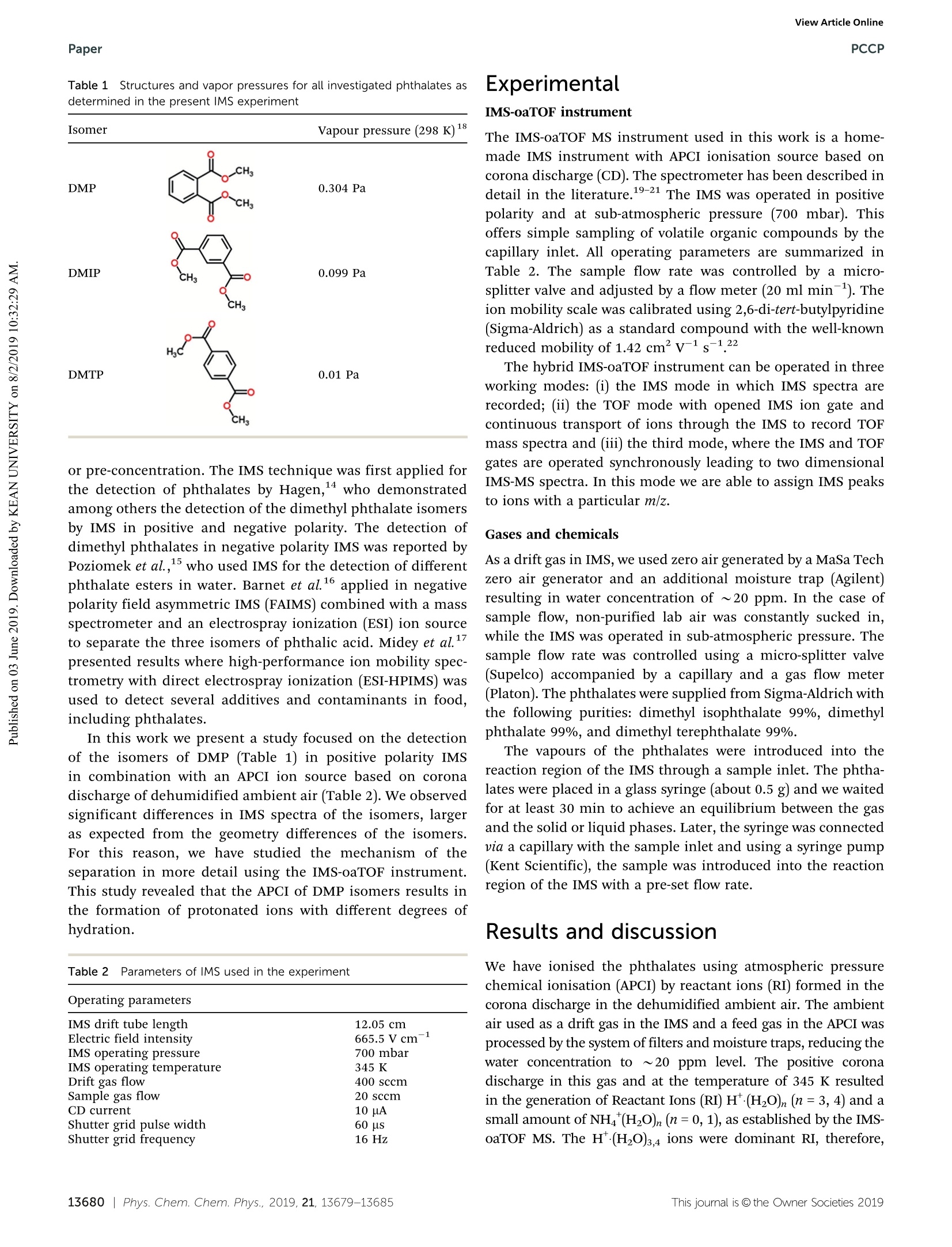
还剩5页未读,是否继续阅读?
继续免费阅读全文产品配置单
图拉扬科技有限公司为您提供《食品,包装,玩具,化妆品中邻苯二甲酸盐检测方案(离子迁移谱仪)》,该方案主要用于其他中邻苯二甲酸盐检测,参考标准《暂无》,《食品,包装,玩具,化妆品中邻苯二甲酸盐检测方案(离子迁移谱仪)》用到的仪器有MCCGC-AIMS PeakMachine气相离子迁移谱、PAIMS离子迁移谱系统。
我要纠错
相关方案


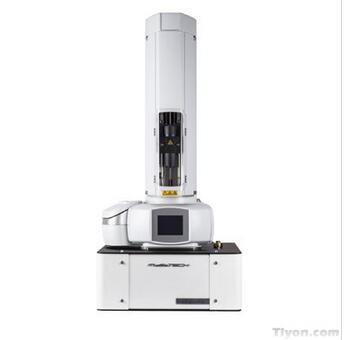
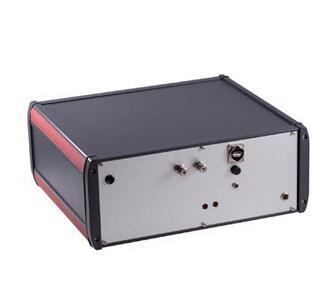
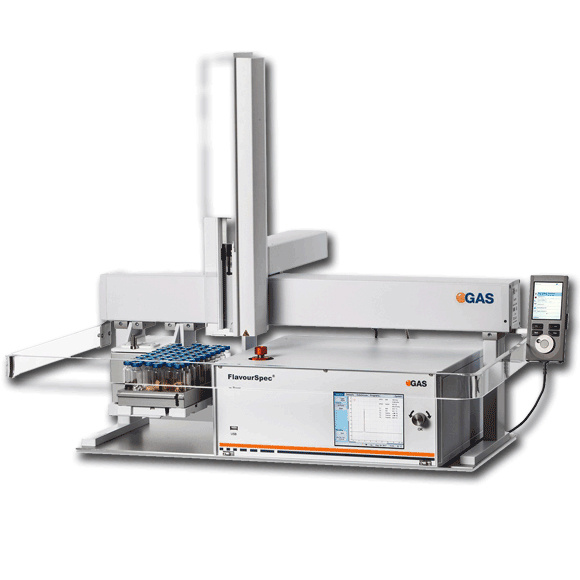
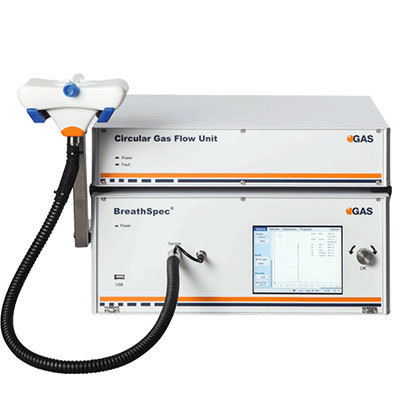
 咨询
咨询






